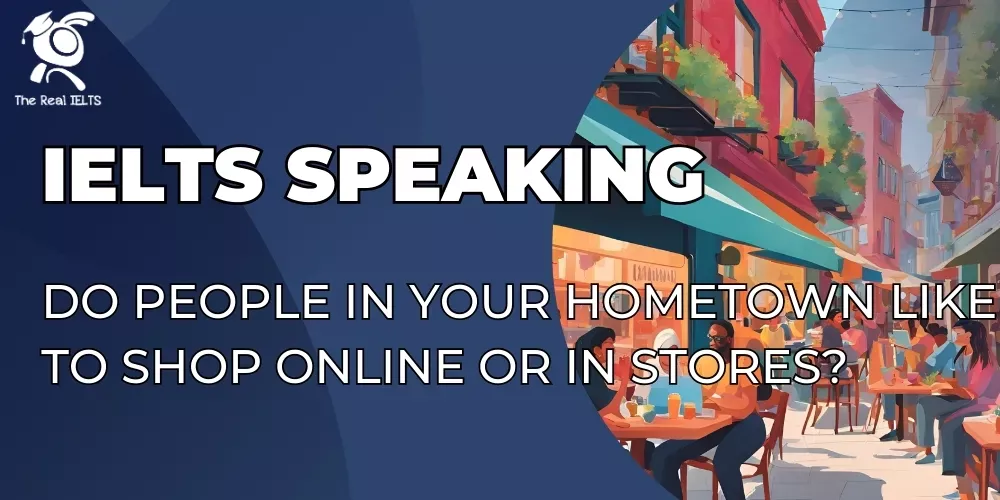Bài viết IELTS Speaking này sẽ so sánh xu hướng mua sắm trực tuyến và mua sắm truyền thống tại quê hương, nhấn mạnh sự thay đổi trong thói quen tiêu dùng của người dân.
Đọc thêm các bài luyện thi IELTS khác.
Đọc thêm câu hỏi khác tại: IELTS Speaking Part 1: Introduction and Interview chủ đề Your hometown.
Đọc thêm: IELTS Speaking: Are there many foreigners living in your hometown?
Câu trả lời cho IELTS Speaking: Do people in your hometown like to shop online or in stores?
Ví dụ 1
Well, in my hometown, which is a moderately sized city, people have quite diverse shopping preferences. Both online and in-store shopping have their own appeal depending on the person, their needs, and sometimes even their age group or occupation.
For younger people, particularly students and young professionals, online shopping is incredibly popular. This is largely because of the convenience it offers. Many of them have busy schedules, so being able to browse through items, compare prices, and place orders from their phones or laptops is a huge advantage. Online platforms like Shopee, Lazada, and Tiki are extremely popular, as they frequently offer discounts, flash sales, and free delivery. Additionally, there’s a wider variety of products available online, and people don’t have to worry about traveling to different shops to find what they want.
That being said, there are still plenty of people who prefer shopping in physical stores. For example, older generations, such as my parents and grandparents, usually feel more comfortable buying things in person. They believe it’s better to see, touch, or try out products before making a purchase, especially when it comes to items like clothes or food. Physical stores also provide the opportunity to interact with salespeople, which some people find reassuring when they’re making big purchases, like electronics or furniture.
Interestingly, even among younger people, certain types of shopping are still more popular in stores. For instance, many people prefer to visit supermarkets or local markets for groceries because they can check the freshness of fruits, vegetables, or meat. Also, there’s a social aspect to in-store shopping—people can go out with friends or family and make it a fun activity.
However, I think the trend is shifting more and more towards online shopping. With the improvement of logistics services and better return policies, even those who were initially hesitant are starting to give it a try. For instance, during the pandemic, many people in my hometown who were used to buying in stores had no choice but to shop online, and they realized how convenient it could be.
In conclusion, while both online and in-store shopping have their dedicated followers, the general trend in my hometown seems to be leaning towards online shopping, especially for its convenience and variety. That being said, physical stores aren’t going away anytime soon, as they still offer unique benefits for certain products and situations.
Ví dụ 2
In my hometown, shopping habits vary quite a bit depending on factors like age, lifestyle, and even the type of product people are looking for. Both online shopping and shopping in physical stores are common, but the preference really depends on individual circumstances.
For example, online shopping is very popular among younger people, especially those in their 20s and 30s. This group tends to prioritize convenience and speed, which are the biggest advantages of shopping online. With just a few clicks, they can browse through thousands of items, compare prices, and have their orders delivered directly to their homes. Platforms like Lazada and Shopee, which frequently offer discounts and free shipping, make online shopping even more attractive. Additionally, for people with tight schedules, such as students or young professionals, it saves a lot of time compared to visiting stores in person.
On the other hand, shopping in physical stores still holds strong appeal, particularly for older generations or those who value the experience of seeing and touching products before buying them. For example, my parents often prefer visiting stores when buying clothes, as they can check the fabric and try on items to ensure they fit properly. Similarly, when it comes to fresh produce, many people in my hometown prefer going to local markets or supermarkets because they can select the freshest items and interact with vendors directly.
That being said, some people choose based on the type of product. For instance, electronics and gadgets are often purchased online because of the detailed reviews and technical specifications available on e-commerce websites. However, for expensive items like furniture, many prefer to visit a store to see the product in person before committing.
It’s also worth mentioning that the pandemic played a significant role in shifting shopping habits in my hometown. During lockdowns, people of all ages were forced to rely on online platforms for essentials, and many became more comfortable with this method of shopping. Even now, a lot of them continue to shop online because they’ve realized how convenient it is.
In conclusion, while online shopping is gaining popularity, especially among the younger generation, physical stores remain an important part of people’s shopping habits in my hometown. I think both forms of shopping will coexist in the future, with each serving different needs and preferences.
Ví dụ 3
In my hometown, people have mixed preferences when it comes to shopping. Some strongly favor online shopping, while others prefer going to physical stores, and the choice often depends on factors like age, lifestyle, and the type of product they’re buying.
Let me start with online shopping. It’s becoming increasingly popular, especially among the younger generation. People in their 20s and 30s tend to choose online platforms because of the convenience they offer. You can shop anytime and anywhere, whether you’re at home or on the go. Popular e-commerce websites like Shopee, Lazada, and Tiki offer competitive prices, frequent promotions, and even free shipping. Plus, with features like customer reviews and detailed product descriptions, buyers feel more confident about their choices. This is especially true for items like electronics, books, and fashion, which don’t always require hands-on inspection.
On the other hand, there are still many people who prefer shopping in physical stores, especially the older generation. They often feel more comfortable seeing and touching the products before buying. For example, my mom likes to go to local markets or supermarkets for fresh produce like fruits and vegetables because she trusts her own judgment when it comes to quality and freshness. Similarly, some people prefer in-store shopping for clothes, as they can try them on and ensure they fit perfectly before making a purchase.
Interestingly, I’ve noticed that shopping habits also change depending on the product. For example, groceries and everyday essentials are still commonly purchased in stores. However, for more specialized items, like electronics or home appliances, people are gradually leaning toward online platforms because they can compare specifications and prices more easily.
The pandemic also played a big role in shaping shopping behaviors. During lockdowns, many people turned to online shopping out of necessity. Even those who were initially hesitant started ordering things like groceries, clothing, and even furniture online. As a result, people became more accustomed to the convenience, and this trend continues today.
To sum up, while online shopping is undeniably growing in popularity in my hometown, physical stores still hold an important place, particularly for items where quality assessment or personal interaction is important. I believe that both methods have their strengths, and people will continue to use them based on their needs and preferences.
Ví dụ 4
In my hometown, people’s shopping preferences are quite diverse, and the choice between online shopping and shopping in physical stores really depends on their age, lifestyle, and what they’re looking to buy.
For many younger people, online shopping is the go-to option. It’s incredibly convenient, especially for those with busy schedules. They can shop anytime, even late at night, without having to leave the house. Popular online platforms like Shopee, Lazada, or Tiki make it easy to browse a wide variety of products, compare prices, and even read reviews from other customers before making a purchase. These platforms also have frequent discounts and promotions, which are a big attraction for younger shoppers. For items like gadgets, clothes, and household products, online shopping saves a lot of time and effort.
However, there’s still a significant number of people who prefer shopping in stores, especially older generations. My parents, for example, enjoy going to supermarkets or traditional markets for groceries. They believe it’s important to personally check the freshness of fruits, vegetables, or meat before buying. Similarly, for items like clothes, they like to try them on to ensure the fit and quality. Shopping in stores also provides a social element, as people often go with friends or family, turning it into a shared experience.
That being said, certain types of products influence the choice as well. For instance, electronics are often purchased online because it’s easier to compare features and prices on websites. But for large purchases like furniture or appliances, many people still prefer visiting physical stores to see the actual product and ask questions directly to the sales staff.
Interestingly, the pandemic has also had a big impact on shopping habits in my hometown. During the lockdowns, even those who had never shopped online before were forced to try it. As a result, a lot of people discovered how convenient it could be and have continued using online platforms even after things returned to normal.
In conclusion, while online shopping is becoming more popular, especially among younger people, physical stores remain essential for certain products and for those who value the in-person experience. Both forms of shopping have their unique advantages, and I think they will continue to coexist in the future.















